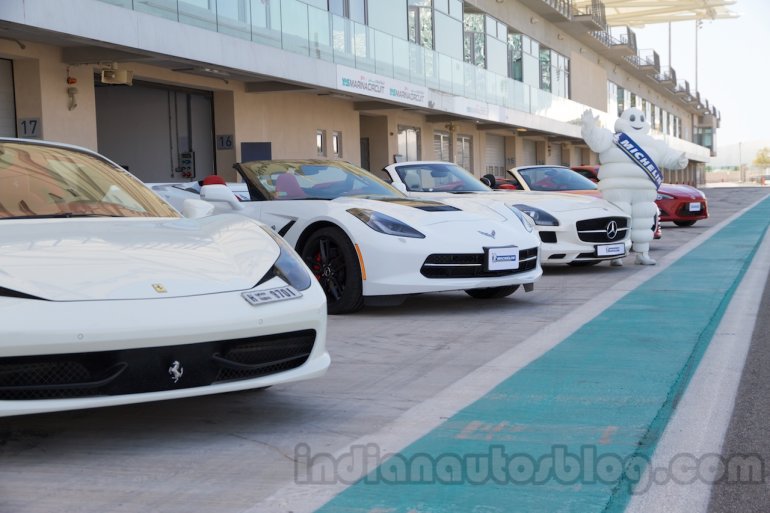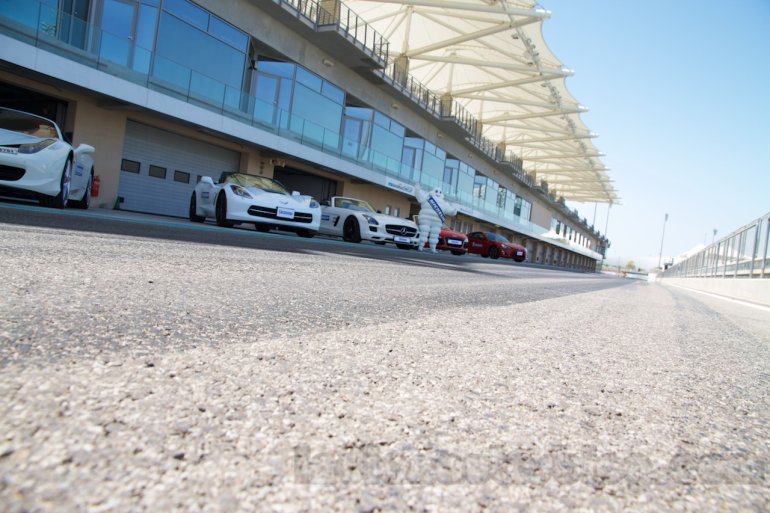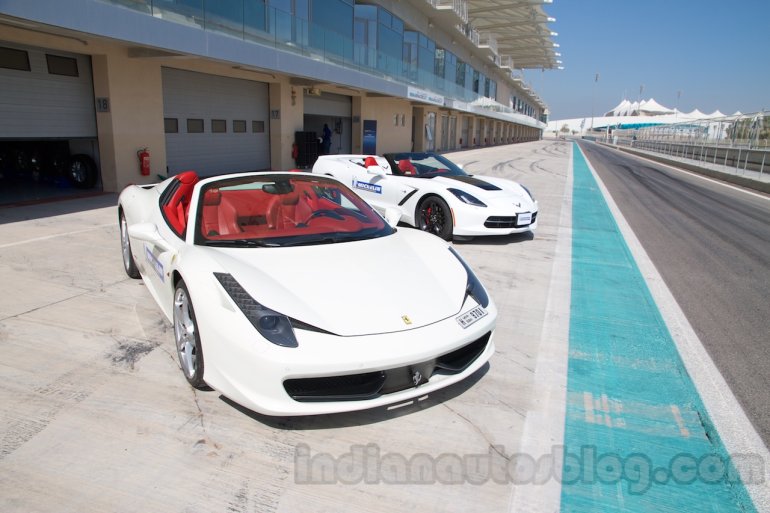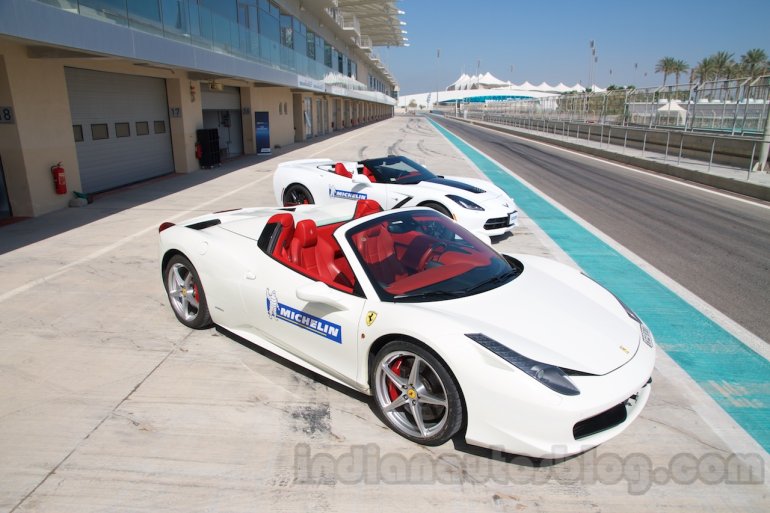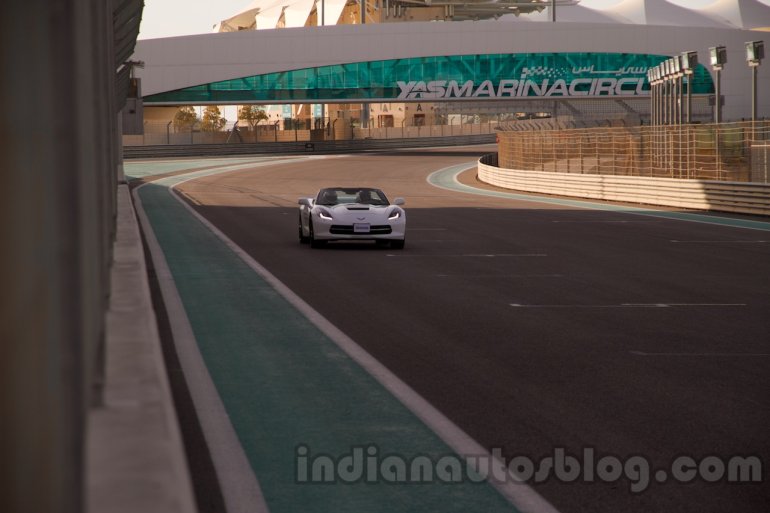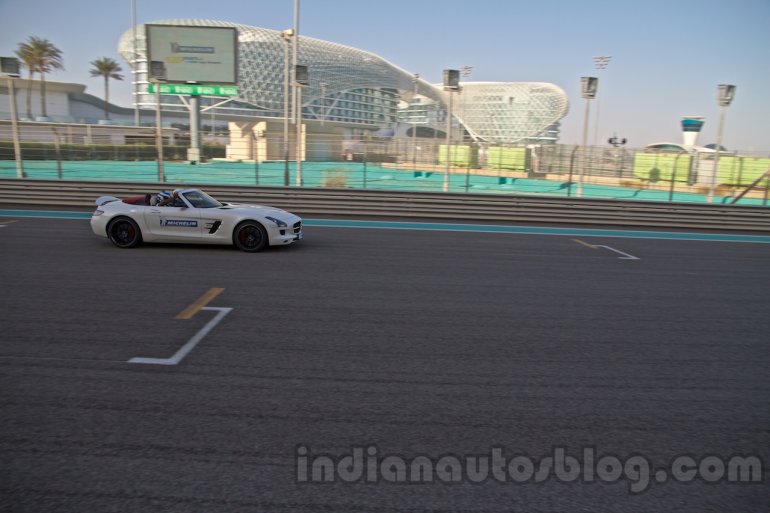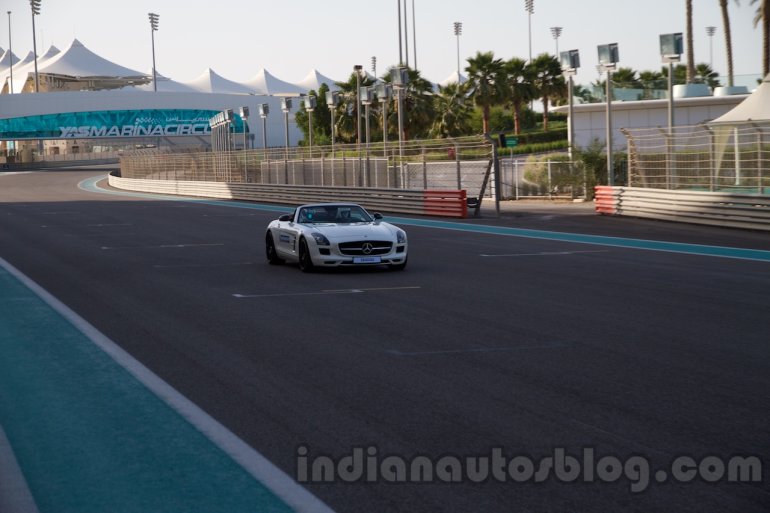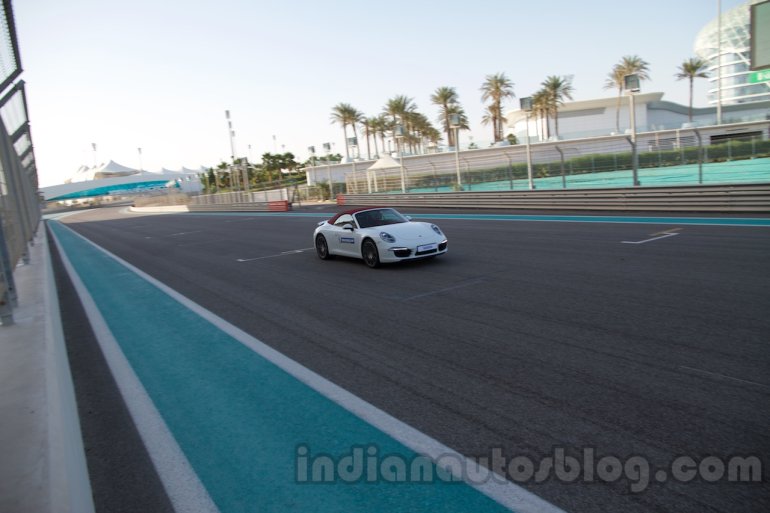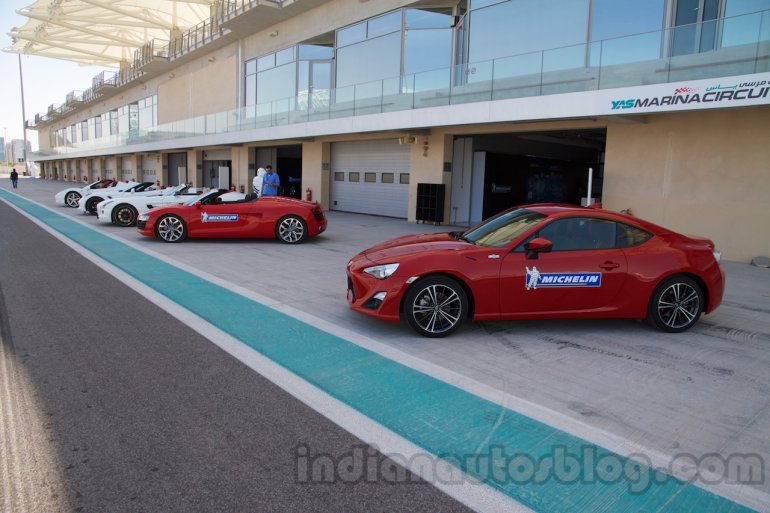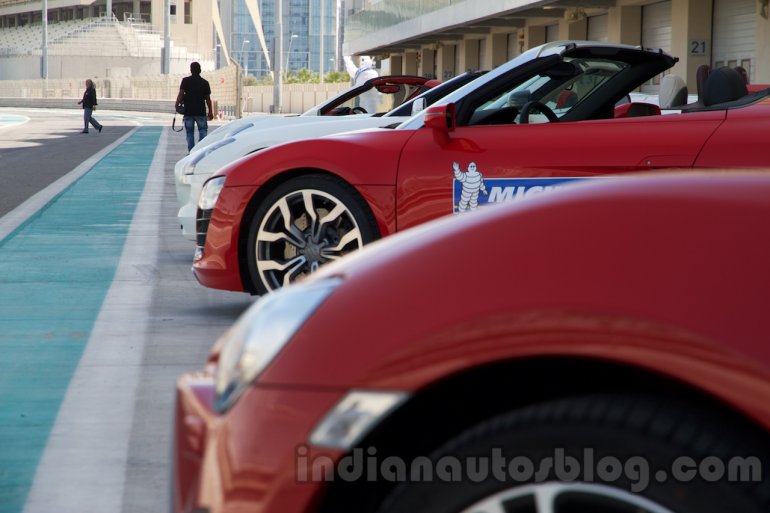Michelin is celebrating their 125th anniversary by inviting people from all over the world to experience the capabilities of their performance-oriented tyres, and the exciting cars that wear them. We were invited to the drive event in Abu Dhabi to experience first-hand on the benefits of Michelin's various range of tyres.
The following article is divided into four parts: Drive experience, Heritage, Innovation, Motorsports, Safety,
Drive Experience
Around the Yas Marina Circuit
It’s not everyday that we get to drive such high performance cars on the Yas Marina circuit, so it was experience worth the travel. We did manage to grasp the best of what was offered, and below is the respective description on the driving experience of the cars present at the event
Ferrari 458 Spider
I know you must be expecting a competitive track time to start with, but, sadly, we used only a section of the track and were accompanied by an instructor, who insisted that we keep the traction control on at all times. Nevertheless, the Ferrari 458 Spider running on Michelin Pilot Sport Cup 2, was the quickest around the track, tackling corners with relative ease and raising goosebumps each time the pedal met the metal.
Chevrolet Corvette Stingray
It was the first time I’ve sat behind the wheel of a Corvette, so I can’t give a detailed comparison to its predecessor. However, I can tell you that the Stingray was fast. It was definitely fun, and even though the electronics interfered a lot(read did most of the “controlling”), the car did allow me to play around a bit.
Mercedes SLS AMG Roadster
The Mercedes SLS AMG Roadster is a complete no nonsense car. Think of it as a straight faced German, who doesn't laugh at your jokes. If you know your way around a race track and have experience in handling powerful RWD V8 supercars, the SLS AMG is one of the fastest track cars. In the hands of a novice, which I am, the traction control system keeps you in the loop, whilst making the driving experience fun.
Porsche Cayman GTS
Nimble, direct, fun. On paper, the Porsche Cayman GTS might not interest you, and its poster would hardly make it into a boy’s collection. Yet, this was the only car that they actually allowed me to use to its full potential on the track. Driving it around the circuit, corner after corner, felt like as if the car was in perfect harmony with the driver.
Toyota GT86
Reading “Toyota” might prompt you to skip to the next paragraph. But, before you move on, just bear with me and have a read. There are some things you like and some things you can sell your kidney for. Well, for me, the Toyota GT86 is classified in the latter. It’s not powerful, the gear shifts aren't as fast as a dual clutch unit, slower on a straight line, and shares its tyre size with that of a Prius. But, once you've driven the GT86, you never go back. Running on Michelin Primacy LC, the car bonds with you instantly. It handles tracks with relative ease, and is always eager to throw a tail out or two. It tries to capture the spirit of old 4-cylinder lightweight RWD sports car, making it the most fun-to-drive-car for a novice.
Heritage
Founded by Édouard Michelin and André Michelin in 1989 in France, Michelin started producing tyres for bicycles but with innovation on its mind, it wasn’t long before Michelin, in 1891, patented the removable and repairable tyres which could be repaired in just about 20 minutes against the conventional tire’s 2 days time. For a more factual presentation, read the following timeline of Michelin’s achievements.
- 1889 Founding of Michelin et Cie.
- 1891 Michelin files its first patents for removable and reparable tyres.
- 1895 Michelin introduces Éclair, the first car fitted with pneumatic tyres.
- 1898 Birth of Bibendum, the Michelin Man.
- 1900 First Michelin Guide published.
- 1905 Introduction of the “semelle Michelin” tread with hobnails to improve tyre grip.
- 1913 Michelin invents spare wheel in the form of a removable steel wheel.
- 1923 First low-pressure car tyre (2.5 bar).
- 1926 Michelin creates its first Green Guide for tourists.
- 1930 Michelin files a patent for the integrated tube tyre.
- 1938 Michelin introduces Metalic, the first truck tyre with a steel casing.
- 1946 Michelin receives a patent for its revolutionary radial tyre.
- 1959 Michelin introduces the first radial tyre for earthmovers.
- 1979 The MICHELIN radial tyre wins the Formula 1 championship with Ferrari.
- 1981 The MICHELIN Air X is the first radial aircraft tyre.
- 1992 Launch of the fuel-efficient MICHELIN ENERGY™ tyre.
- 1995 The US space shuttle lands on Michelin tyres.
- 1998 The first Michelin Challenge Bibendum, the leading international clean vehicle event.
- 1998 The Michelin Man’s 100th birthday.
- 2000 The Michelin Man elected best logo of all time by an international jury.
- 2001 Michelin brings to market the world’s largest earthmover tyre.
- 2003 Launch of a range of MICHELIN brand automotive accessories.
- 2006 Michelin revolutionizes truck tyres with MICHELIN Durable Technologies.
- 2007 Launch of the new MICHELIN ENERGY™ Saver tyre, which reduces fuel consumption by nearly 0.2 liters per 100 kilometers, thereby avoiding the release of nearly 4g/km of CO2.
- 2010 Market launch of the MICHELIN Pilot Sport 3 and MICHELIN Pilot Super Sport tyres.
- 2011 Introduction of the MICHELIN Pilot Road 3, the first dual-compound tyre with sipes.
- 2013 Market launch of the ultra high performance MICHELIN Pilot Sport Cup2, the only tyre certified for use on the new Ferrari 458 Speciale, Porsche 918 Spyder and AMG SLS Black Series
- 2014 The MICHELIN Premier A/S car tyre with a self-regenerating tread is presented at the North American International Auto Show in Detroit
- 2015 Michelin launches CrossClimate in Europe, a breakthrough tyre that runs through summer and winter
- 2015 Michelin celebrates the brand’s 125th Anniversary
Innovation
Guess how many components does it take to manufacture a tyre?
No, it’s not just an iron reinforced molded rubber. It takes over 200 components to manufacture a single tyre. The rubber alone is made from four different components.
The components involved in the tyre manufacturing process are divided into four categories:
- Rubber or elastomer – Available in two forms i.e. natural (from trees) or synthetic (from oil), the rubber is extracted and shredded for further process.
- Reinforcing fillers – The main aim is to provide rubber with wear protection. Eg. Silica, carbon black etc.
- Plasticizers – In order to make the rubber more flexible, plasticizers like oil and resin are added to facilitate extrusion.
- Chemical additives – Available in powder or granular form, chemical additives such as sulphur, help in regular formation of a tire.
Further layers of iron cables in cross section and textile chords of nylon and aramid (kevlar) are added to further strengthen and retain the shape of the tire.
Fact check – It took Michelin about a year and a half’s time to develop the tyre for the world’s fastest production car the Bugatti Veyron.
Motorsports
Michelin has long been associated with motorsports. It was the first tyre manufacturer to ever win the world’s first long distance cycle (Paris–Brest–Paris) race in France in 1891 and inventing the radial tyre that were used in Formula 1 cars in 1979. Michelin is the only tyre manufacturer to hold an envious amount of trophies, and here's a list of their victories:
Le Mans 24 Hours:
- First win in 1923 (inaugural race)
- 23 wins (including 17 straight wins since 1998)
- 13 wins with Audi, 9 of them being with Tom Kristensen
FIA World Rally Championship (WRC):
- First Manufacturers’ title with Alpine in 1973 (first year of the championship)
- 46 world titles (22 Drivers’ titles and 24 Manufacturers’ titles)
- First win in the 1973 Rallye Monte-Carlo (Andruet/Biche, Alpine-Renault)
- More than 250 individual event wins
FIA World Endurance Championship (WEC):
- Three world titles since the championship’s creation in 2012
Dakar:
- Cars: 18 victories between 1981 and 2001, and since 2013
- Bikes: 32 victories between 1983 and 2014
- Trucks: 32 victories between 1981 and 2014
Formula 1 (1977 to 1984, and 2001 to 2006):
- 215 Grands Prix
- 111 pole positions
- 102 victories
- 5 Drivers’ titles
- 4 Constructors’ titles
FIM Endurance World Championship (EWC) (1983 to 2014):
- 15 world titles
- 24 Heures Moto: 13 victories
- Bol d’Or: 13 victories
- 8 Hours of Suzuka: 16 victories
Trial World Championship
- 33 Trial Outdoor world titles since 1981
- 13 Trial Indoor world titles since 2002
Enduro World Championship
- 31 world titles since 2000
Motocross
- 7 world titles since 2002
FIM MotoGP (1973 to 2008):
- 26 Riders’ world titles
- 360 race wins
- First win in 1973 (Jack Findley, Suzuki)
- First title in 1976 (Barry Sheene, Suzuki)
FIM World Superbike Championship (WSBK) (1998 to 2003):
- 12 world titles
Fact check – The Shell Eco Marathon is an annual event that focuses mainly on fuel efficiency. Michelin provided the low rolling resistance tyres for the French team Lycée La Joliverie that currently holds the record of driving 3,410 km on the equivalent of single liter of fuel.
Safety
Ever wondered why does a tyre have uneven wear or why does it explode? What is the right way to fix a puncture? Read along to clear all your doubts.
Let’s start with something as basic as the letters written on the sidewall of a tire. For eg. 275/40 R 20 106 Y where in :
- 275 determines the nominal tyre width in mm.
- 40 stands for aspect ratio (ratio of height to width).
- R stands for radial construction.
- 20 determines rim seat diameter in inches.
- 106 states the load capacity index.
- Y determines the maximum speed index.
Every tyre is purpose built, either for a family wagon or the earthmover. Hence the materials used and and all the indexes stated above change accordingly. For instance, the low profile tyres built for sportscars give the sidewall extra strength required during high speed cornering, whereas high profile tyres used in daily drives give the cushioning effect, making the ride smooth.
Two main precautions you need to keep in mind:
- Choose wisely live well - choose the right type of tyre suited for your vehicle and buy from a trusted manufacturer. Getting the tyres re-treaded is a strict NO.
- Tire pressure - keep the right amount of pressure in your tire as suggested by the manufacturer visually inspecting them every time you need to drive and weekly checking the pressure mechanically.
Consequences of over inflation.
Sometimes people will suggest you to over inflate the tyres aiding to better fuel economy and to some extent they are right. But from a tyre’s point of view, the contact patch decreases wherein since the tyre is bulging, only the inner tread will be in contact with the surface leading to uneven tyre wear and less grip as well.
Consequences of under inflation
Track days, off-roading are places where you tend to decrease the tyre pressure to increase grip. When off-roading it is a feasible option since the surface is softer but you should to re-inflate the tyres as soon as you hit tarmac. On road though, less tyre pressure causes the tyre to bulge inwardly causing uneven wear as only the outer tread lines are in constant contact with the surface. Another disadvantage of under inflated tire is marbling. In the earlier stage, Marbling is caused internally wherein a black line appears inside of the side wall and with constant running on low pressure, the black line appears externally as well. This happens due to the rim often riding on the tire’s sidewall damaging the steel and aramid cable mesh which other wise holds a tire in its form. Under inflation is the no.1 cause of tire bursts
What is the correct way to fix a puncture?
Commonly used, the plug repair, takes just a couple of minutes and can sometimes be done with the wheel still attached to the vehicle. This does fix the puncture but is considered only a temporary fix as there’s always a chance of leak as the plug is nothing but a thread with glue on it.
The correct way of fixing a puncture is by plugging in the mushroom type plug. This is plugged in internally and requires the tire to be removed from the wheel, checked for any signs of marbling, then plugging in the mushroom plug, replacing the tire on the wheel and since the tire was removed, the wheel needs to be re-balanced. Normally this process takes about 30-40 minutes, is labour as well as equipment intensive hence costly. But it surely is the right thing to do.
Fact check – 53% of car tyres suffer a puncture during their life span.
We got a chance to practically examine the difference between perfectly inflated tyres and under inflated tyres around the slalom course in a similarly spec’d Toyota Camry. The appropriate pressure helped the car maneuver around the circuit with ease as the complete tyre tread patch was in contact with the surface and the steering was direct and confident.
Immediately after that we got into the second car, which had under inflated tyres. The hard and a bit wobbly steering was immediately noticed and the uneven wear on tires was demonstrated after we were done with our laps.
Second safety activity highlighted the braking distance over various speeds. At 60kmph, it takes an average car about 8-9 meters to come to a complete halt. At 100kmph though, the distance a car takes to stop is more than three times and for an average commuter, it stands at 31-33 meters.
After a thorough driving experience behind the wheel of five different cars, guided by few of the best instructors, I can say that the Michelin 125th anniversary experience is a memory to cherish for a lifetime.
